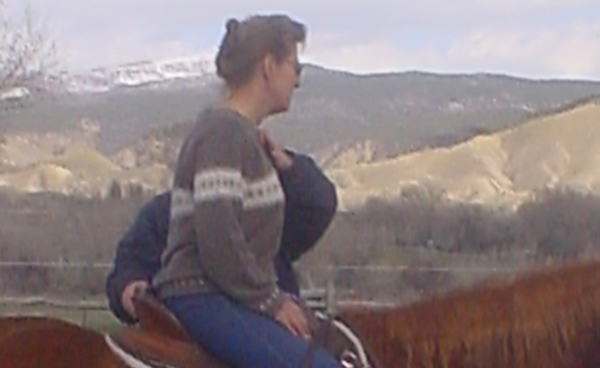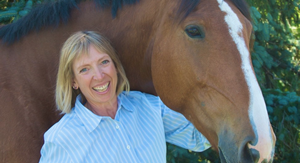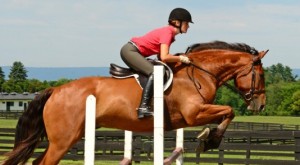One of the main ideas with a variety of TTEAM exercises is to lower the horse’s head, release back and bring the hindquarters under. Methods such as lowering the head with and without the chain, raising the back, body wraps and pelvic tilts all encourage the horse to lengthen the topline (the distance from the poll to the dock), engage the abdominal muscles and connect the front end to back end. Releasing the horse’s topline allows him to bring the hindquarters under so that he can track up (hind foot stepping into the print of the front foot). With the hind feet tracking up, the thrust from the hind feet will help lift the back, provide balancing support for down transitions and will make the horse’s job of carrying the rider’s weight a lot easier. If the rider (or saddle) blocks the horse from lifting the back, the horse will either go above the bit or behind the bit in order to avoid discomfort.
Next, think about butt walking. You remember, when you were a kid and you would sit on the floor and moving yourself along by scooting each side of your pelvis forward on the floor. When you think about doing this on the chair notice whether you want to lift the pelvis up to move it forward or if you can simply slide the pelvis forward. You want to be able to slide without much lifting. Observe how the knee on the side you are moving advances over your foot. In order for this to happen you have to allow the knees to go out over your second toe. If you pinch your knees together you will not be able to butt walk. Instead you will simply waddle side to side. You can butt walk yourself to the edge of the chair and back again as long as the chair has a fairly level, flat surface. By “butt walking” on the chair backwards you can get the feeling of letting the ball of the hip joint sink back into the socket. This is an important feeling to remember when riding. Often times when we are on the horse the ball of the hip joint gets pressed against the front of the socket. This can cause the horse to stiffen and rush. By letting the ball move towards the back of the socket the hip joint softens and the horse can slow down or shift his balance onto his hindquarters.
Finally stand up again and do the following exercise. This exercise will show you the importance of having your pelvis in a neutral position so that your hips can move freely. It also demonstrates what happens to the horse’s hips and his ability to track up depending upon the angle of his pelvis. Remember to be gentle with your body during all of these exercises. If anything causes you pain – stop! These exercises are simply to give you and understanding of a concept, not to hurt you.
Start by standing up. Now assume the posture of a rider with an arched back or a head high hollow backed horse standing up (same thing actually). Now pick up one knee and notice how easy or difficult it is for you to raise your leg. Did you have to shift your weight to the other leg? How much did you shift? How easy is it to sustain this position? Put your leg down and assume a “c” curve rider position (same as horse behind the bit). Get good and slumpy. Notice that you have flattened the crease of your hip joints when you slump. Again, pick up one leg. Notice how difficult or easy it is and how you have to redistribute your weight in order to lift the knee. Finally, find a neutral pelvic position with your seat bones pointing down towards the ground and your sacrum hanging down. Feel your lower back to make sure it is not rounded or arched. Pick up your knee again. How easy or difficult was it? Did you notice that you did not have to shift your weight nearly so much in order to pick up your knee?
Compare the different positions; hollow back, “c” curve and neutral in relation to picking up one knee. Which position took the least amount of effort? If you said the neutral position then I agree with you, as do all of my students. When the pelvis is in a neutral position the ligament which runs over the neck of the femur between the pelvis and the femur, releases. This reduces the tension in the hip joint making it easier to lift the leg. Notice that in the hollow back position the sacrum is tipped up so that the pelvis pitches forward and down. In the “c” curve position there was very little fold in the hip joint and you wind up bending at the waist which inhibits the movement in the hip joint.
If you consider the horse for a moment you will realize that if he is behind or above the bit (as you just simulated) it will be harder for him to track up then when he is on the bit (back up, pelvis under, release in hip joints). He will have to work through the resistance in the hip joints just like you felt in your own hip joints. Many horses are driven through this resistance. However, if you get the horse to lengthen his top line he will have an effortless swing in the hind legs instead of always having to drive him on.
Returning to the standing exercise, if you fold the joints of hip knee and ankle of the supporting leg with the pelvis in a neutral position, it is still easy to lift the knee. You might notice that you have tucked your pelvis under you a bit more as you folded the leg joints. This is similar to what happens to the horse in a more collected frame; the hindquarters lower and the hips are still free to come under. Do this again with a hollow back or a “c” curve back and notice that there is a great deal of strain placed on your knees (horse’s stifles) and it is difficult to hold your balance for any length of time. Next time you watch someone riding their horse in collection consider whether the horse is lowering his pelvis to do it or if he is stiffening. You will know how that feels now that you have experimented.
Hopefully you now have a much clearer idea about your hip joints, pelvis and how they work. Next time you ride your horse, place your hand on your lower back. Observe which position your pelvis is in; hollow, “c”curve or flat. If you have constantly been struggling to get your leg longer by lengthening your stirrups and you notice that your back is hollow, I suggest you shorten your stirrups a hole or two. Once you are able to keep the back full by developing the proper muscle strength in the back, go ahead and let your stirrups down gradually again. I think you will find that you will be able to keep your feet where they belong even at the longer length once you have strengthened your back to maintain the pelvis in a neutral position. Also notice that your leg hangs more freely. Play with the idea of the ball moving back into the socket to slow the horse down. As you become more aware of your hip joints notice what happens to your horse’s movement. Does his stride increase? Are down transitions easier. Can you maintain your sitting trot with less effort? So much of riding is centered around the hips, pelvis and lower back, I promise that any effort you make to become more aware of this part of your body will help improve your riding. Good luck and enjoy!
Copyright© 2000. All rights reserved.




